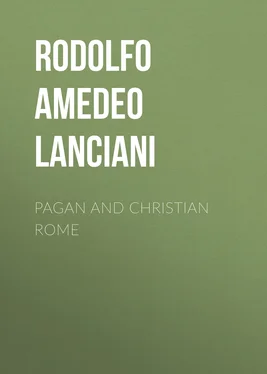Rodolfo Amedeo Lanciani - Pagan and Christian Rome
Здесь есть возможность читать онлайн «Rodolfo Amedeo Lanciani - Pagan and Christian Rome» — ознакомительный отрывок электронной книги совершенно бесплатно, а после прочтения отрывка купить полную версию. В некоторых случаях можно слушать аудио, скачать через торрент в формате fb2 и присутствует краткое содержание. Жанр: foreign_edu, История, История, на английском языке. Описание произведения, (предисловие) а так же отзывы посетителей доступны на портале библиотеки ЛибКат.
- Название:Pagan and Christian Rome
- Автор:
- Жанр:
- Год:неизвестен
- ISBN:нет данных
- Рейтинг книги:3 / 5. Голосов: 1
-
Избранное:Добавить в избранное
- Отзывы:
-
Ваша оценка:
- 60
- 1
- 2
- 3
- 4
- 5
Pagan and Christian Rome: краткое содержание, описание и аннотация
Предлагаем к чтению аннотацию, описание, краткое содержание или предисловие (зависит от того, что написал сам автор книги «Pagan and Christian Rome»). Если вы не нашли необходимую информацию о книге — напишите в комментариях, мы постараемся отыскать её.
Pagan and Christian Rome — читать онлайн ознакомительный отрывок
Ниже представлен текст книги, разбитый по страницам. Система сохранения места последней прочитанной страницы, позволяет с удобством читать онлайн бесплатно книгу «Pagan and Christian Rome», без необходимости каждый раз заново искать на чём Вы остановились. Поставьте закладку, и сможете в любой момент перейти на страницу, на которой закончили чтение.
Интервал:
Закладка:
"There is no harm in seeking strength and purity of body in baths; it is not water but our own bad actions that make us sin." These verses are not so good as their moral; but inscriptions like this prove that the abandonment of such useful institutions must be attributed not to the undue severity of Christian morality, but to the ruin of the aqueducts by which fountains and baths were fed. However, even in the darkest period of the Middle Ages we find the traditional "kantharos," or basin, in the centre of the quadri-porticoes or courts by which the basilicas were entered. Such is the vase in the court of S. Cæcilia, represented on the next page, and that in front of S. Cosimato in Trastevere; and such is the famous calix marmoreus , which formerly stood near the church of SS. Apostoli, mentioned in the Bull of John III. (a. d. 570), by which the boundary line of that parish was determined. This historical monument, a prominent landmark in the topography of mediæval Rome, was removed to the Baths of Diocletian at the beginning of last year.
In many of our churches visitors may have noticed one or more round black stones, weighing from ten to a hundred pounds, which, according to tradition, were tied to the necks of martyrs when they were thrown into wells, lakes, or rivers. To the student these stones tell a different tale. They prove that the classic institution of the ponderaria (sets of weights and measures) migrated from temples to churches, after the closing of the former, a. d. 393.
Kantharos in the Court of St. Cæcilia.
As the amphora was the standard measure of capacity for wine, the metreta for oil, the modius for grain, so the libra was the standard measure of weight. 26To insure honesty in trade they were examined periodically by order of the ædiles; those found iniquæ (short) were broken, and their owners sentenced to banishment in remote islands. In a. d. 167, Junius Rusticus, prefect of the city, ordered a general inspection to be made in Rome and in the provinces; weights and measures found to be legal were marked or stamped with the legend "[Verified] by the authority of Q. Junius Rusticus, prefect of the city." These weights of Rusticus are discovered in hundreds in Roman excavations. 27
The original standards were kept in the Temple of Jupiter on the Capitol, and used only on extraordinary occasions. Official duplicates were deposited in other temples, like those of Castor and Pollux, Mars Ultor, Ops, and others, and kept at the disposal of the public, whence their name of pondera publica . Barracks and market-places were also furnished with them. The most important discovery connected with this branch of Roman administration was made at Tivoli in 1883, when three mensæ ponderariæ , almost perfect, were found in the portico or peribolos of the Temple of Hercules, adjoining the cathedral of S. Lorenzo. This wing of the portico is divided into compartments by means of projecting pilasters, and each recess is occupied by a marble table resting on "trapezophoroi" richly ornamented with symbols of Hercules and Bacchus, like the club and the thyrsus. Along the edge of two of the tables runs the inscription, "Made at the expense of Marcus Varenus Diphilus, president of the college of Hercules," while the third was erected at the expense of his wife Varena. The tables are perforated by holes of conical shape, varying in diameter from 200 to 380 millimetres. Brass measures of capacity were fastened into each hole, for use by buyers and sellers. They were used in a very ingenious way, both as dry and liquid measures. The person who had bought, for instance, half a modius of beans, or twenty-four sextarii of wine, and wanted to ascertain whether he had been cheated in his bargain, would fill the receptacle to the proper line, then open the valve or spicket below, and transfer the tested contents again to his sack or flask.
The institution was accepted by the Church, and ponderaria were set up in the principal basilicas. The best set which has come down to us is that of S. Maria in Trastevere, but there is hardly a church without a "stone" weighing from five or ten to a hundred pounds. The popular superstition by which these practical objects were transformed into relics of martyrdoms is very old. Topographers and pilgrims of the seventh century speak of a stone exhibited in the chapel of SS. Abundius and Irenæus, under the portico of S. Lorenzo fuori le Mura, "which, in their ignorance, pilgrims touch and lift." They mention also another weight, exhibited in the church of S. Stephen, near S. Paul's, which they believed to be one of the stones with which the martyr was killed.
In 1864 a schola (a memorial and banqueting hall) was discovered in the burial grounds adjoining the prætorian camp, which had been used by members of a corporation called the sodalium serrensium , that is, of the citizens of Serræ, a city of Samothrake, I believe. Among the objects pertaining to the hall and its customers were two measures for wine, a sextarium , and a hemina , marked with the monogram of Christ and the name of the donor. 28They are now exhibited in the sala dei bronzi of the Capitoline museum.
The hall of the citizens of Serræ, discovered in 1864, belongs to a class of monuments very common in the suburbs of Rome. They were called cellæ, memoriæ, exedræ , and scholæ , and were used by relatives and friends of the persons buried under or near them, in the performance of expiatory ceremonies or for commemorative banquets, for which purpose all the necessaries, from the table-service to the festal garments, were kept on the spot, in cabinets entrusted to the care of a watchman. This practice—save the expiatory offerings—was adopted by the Christians. The agapai , or love-feasts, before degenerating into those excesses and superstitions so strongly denounced by the Fathers of the Church, were celebrated over or near the tombs of martyrs and confessors, the treasury of the local congregation supplying food and drink, as well as the banqueting robes. In the inventory of the property confiscated during the persecution of Diocletian, in a house at Cirta (Constantine, Algeria), which was used by the faithful as a church, we find registered, chalices of gold and silver, lamps and candelabras, eighty-two female tunics, sixteen male tunics, thirteen pairs of men's boots, forty-seven pairs of women's shoes, and so on. 29A remarkable discovery, illustrating the subject, has been lately made in the Catacombs of Priscilla; that of a graffito containing this sentence: "February 5, 375, we, Florentinus, Fortunatus, and Felix, came here AD CALICE[M] (for the cup)." To understand the meaning of this sentence, we must compare it with others engraved on pagan tombs. In one, No. 25,861 of the "Corpus," the deceased says to the passer-by: "Come on, bring with you a flask of wine, a glass, and all that is needed for a libation!" In another, No. 19,007, the same invitation is worded: "Oh, friends ( convivæ ), drink now to my memory, and wish that the earth may be light on me." We are told by S. Augustine 30that when his mother, Monica, visited Milan in 384, the practice of eating and drinking in honor of the martyrs had been stopped by S. Ambrose, although it was still flourishing in other regions, where crowds of pilgrims were still going from tomb to tomb with baskets of provisions and flasks of wine, drinking heavily at each station. Paulinus of Nola and Augustine himself strongly stigmatized the abuse. The faithful were advised either to distribute their provisions to the poor, who crowded the entrances to the crypts, or to leave them on the tombs, that the local clergy might give them to the needy. There is no doubt that the record ad calicem venimus , scratched by Florentinus, Fortunatus, and Felix on the walls of the Cemetery of Priscilla, refers to these deplorable libations.
Читать дальшеИнтервал:
Закладка:
Похожие книги на «Pagan and Christian Rome»
Представляем Вашему вниманию похожие книги на «Pagan and Christian Rome» списком для выбора. Мы отобрали схожую по названию и смыслу литературу в надежде предоставить читателям больше вариантов отыскать новые, интересные, ещё непрочитанные произведения.
Обсуждение, отзывы о книге «Pagan and Christian Rome» и просто собственные мнения читателей. Оставьте ваши комментарии, напишите, что Вы думаете о произведении, его смысле или главных героях. Укажите что конкретно понравилось, а что нет, и почему Вы так считаете.












